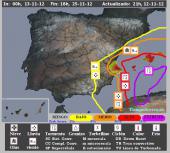Letra B
- B -
Closed Low - A low pressure area with a distinct justify of cyclonic circulation which can be completely encircled by one or more isobars or height contour lines. The term usually is used to distinguish a low pressure area aloft from a low-pressure trough. Closed lows aloft typically are partially or completely detached from the main westerly current, and thus move relatively slowly (see cutoff low). Feeder Bands - Lines or bands of low-level clouds that move (feed) into the updraft region of a thunderstorm, usually from the east through south (i.e., parallel to the inflow). Same as inflow bands. Inflow Bands (or Feeder Bands) - Bands of low clouds, arranged parallel to the low-level winds and moving into or toward a thunderstorm. They may indicate the strength of the inflow of moist air into the storm, and, hence, its potential severity. Spotters should be especially wary of inflow bands that are curved in a manner suggesting cyclonic rotation; this pattern may indicate the presence of a mesocyclone. Bandas de Entrada (o Bandas de Alimentación) - Bandas de nubes bajas, ordenadas de forma paralela a los vientos en niveles bajos y que se mueven dentro o hacia una tormenta. Indican el fortalecimiento de la entrada de aire húmedo dentro de la tormenta y, de ahí, su potencial severidad. Los Observadores deberían ser especialmente cautelosos con las bandas de entrada que se curvan de manera que sugieren rotación ciclónica; este patrón podría indicar la presencia de un mesociclón *Rain-free Base - A dark, horizontal cloud base with no visible precipitation beneath it. It typically marks the location of the thunderstorm updraft. Tornadoes may develop from wall clouds attached to the rain-free base, or from the rain-free base itself - especially when the rain-free base is on the south or southwest side of the main precipitation area. Note that the rain-free base may not actually be rain free; hail or large rain drops may be falling. For this reason, updraft base is more accurate. See HP storm, LP storm, and supercell. *Base libre de lluvia - Base nubosa horizontal, oscura, con precipitación no visible bajo ella. Típicamente marca la localización de la corriente ascendente de la tormenta. Se pueden desarrollar tornados en nubes-pared (wall-clouds) adjuntas a la base libre de precipitación, o en la misma base libre de precipitación, especialmente cuando ésta se localiza en la cara S o SW del área principal de precipitación. Notar que la base libre de precipitación puede no estar libre de precipitación; pueden estar cayendo granizo o grandes gotas de lluvia. Por esta razón, el término “base de la corriente ascendente” es más preciso. Ver Tormenta AP, Tormenta BP, y supercélula. Cold Pool - A region of relatively cold air, represented on a weather map analysis as a relative minimum in temperature surrounded by closed isotherms. Cold pools aloft represent regions of relatively low stability, while surface-based cold pools are regions of relatively stable air. Dry-line Bulge - A bulge in the dry line, representing the area where dry air is advancing most strongly at lower levels (i.e., a surface dry punch). Severe weather potential is increased near and ahead of a dry line bulge. Bubble High - A mesoscale area of high pressure, typically associated with cooler air from the rainy downdraft area of a thunderstorm or a complex of thunderstorms. A gust front or outflow boundary separates a bubble high from the surrounding air.
|
© Spain Severe Weather 2010








